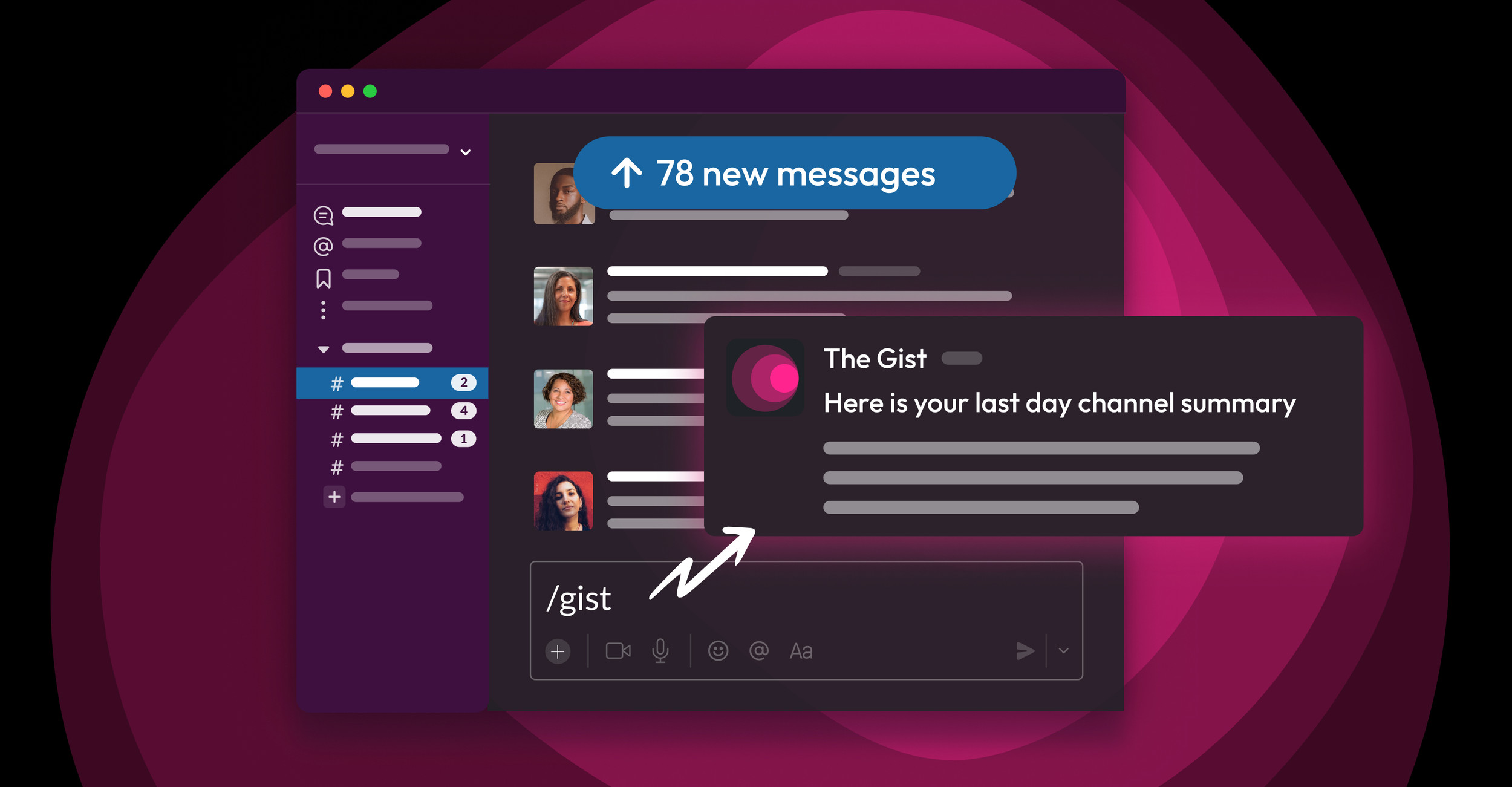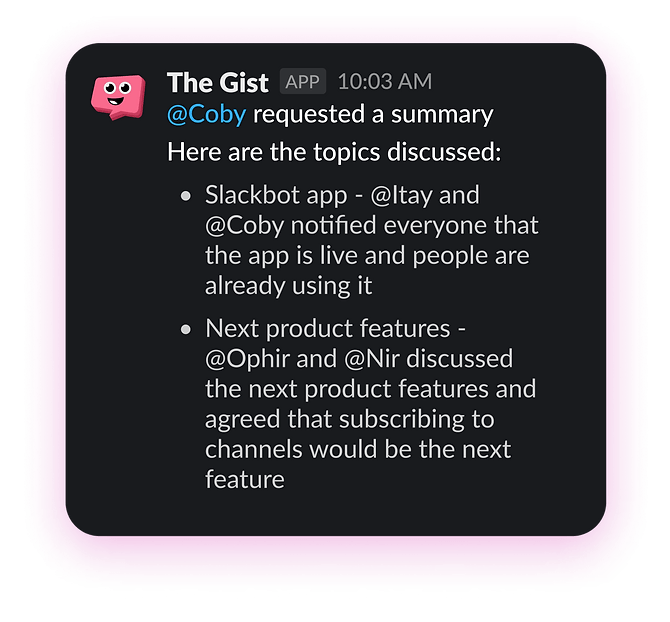Itay Dressler and Itzik Ben Bassat, who’ve held various software engineering and executive roles at startups together over the years, are accustomed to exchanging brief messages. Ben Bassat has ADHD, and for that reason prefers to keep texts on the shorter side. But as he and Dressler were faced with wrangling an increasing number of tools at their employers, they came to realize they weren’t the only ones who could benefit from more succinct updates.
So they founded TheGist with the grand mission of “simplifying information consumption in workplace communications and data” through instant highlights. The startup’s first product uses AI to scan Slack messages and provide a personalized summary, aiming to filter out noise.
And in the enterprise, there’s plenty of noise to filter. According to a 2021 report in Tech Republic, a survey of remote workers showed that 18% suffered from “information overload” while 8% were overwhelmed by the amount of data and apps they were meant to check each day.
“There’s an overload of software-as-a-service (SaaS) applications that aren’t deeply integrated. Different teams use different tools to create information silos,” Ben Bassat told TechCrunch in an email interview. “The integration between those SaaS tools makes the information overload greater, not smaller. There is no reason that in 2022, using AI, employees can’t get the information they need to make better decisions in a short and personalized form.”
Installing TheGist’s Slack app — which can summarize both channels and threads — is a straightforward-enough process. Once connected to a workspace, the app can be added or invited to channels that a user wishes to summarize. Typing the command “/gist” summons it, generating a fresh summary — generally a bullet point or two in length — of what happened in the channel, visible only to the person who requested it.

Image Credits: TheGist
TheGist Slack app can provide summaries covering time scales from one day to several weeks. Beyond this, it can summarize particularly long individual Slack messages. Service is free for up to five summaries but unlimited summaries requires a premium subscription, which starts at $10 per user per month.
“We wanted to release a tool that highlights the need for shortening the information overload in companies,” Ben Bassat said. “TheGist is a game changer for decision makers as we enable managers to dramatically increase the amount of workplace information they can consume by digesting it and personalizing it … For employees, we serve them the information they need when they need it so they can be aligned with the organization and make better and more knowledgeable decisions.”
That’s a lot to promise. AI, while improving by leaps and bounds, has its limitations; TheGist’s summaries are bound to contain mistakes from time to time. And from a security standpoint, companies might be loathe to let a third-party app process the internal messages — particularly companies in highly regulated industries.
Ben Bassat didn’t provide much in the way of detail around TheGist’s AI systems and their development, save that it’s leveraging “multiple open source large languages models” with “specific in-house fine-tuning.”
“We are using statistical models to evaluate our models’ output and assess correctness,” Ben Bassat said. “As in every product which is generated by AI, results can have summary errors, and our users are made aware of that.”
On the compliance question, Ben Bassat claims that TheGist doesn’t store Slack data other than the specific messages users ask to summarize, which it deletes after the summaries are generated.
“We only store analytical and usage data in order to improve our product and personalize the user experience. Users can ask to delete their data according to our privacy policy,” Ben Bassat added.
There aren’t a lot of competitors in the Slack summarization space. But there are a few, it’s worth noting. Frame summarizes the previous day’s Slack activity, providing metrics including team responsiveness and auto-detected “high” and “low” moments. Grok, a Slack app, provides summaries of Slack conversations and threads generated by OpenAI’s GPT-3 API. There’s also TLDR, which uses algorithms to spit out Slack message summaries.

Image Credits: TheGist
But Ben Bassat and co don’t see TheGist’s first app as the endgame. In parallel to it, Ben Bassat says that the company’s on the cusp of releasing “proprietary generative AI solutions” for different platforms in the near future — although it’s not clear for which platforms and what types of generative AI. Ben Bassat didn’t have much to say on the subject, which suggests that the specifics are in flux.
“The goal of our platform is to enable anyone to be informed with short updates from any app they use for communication or productivity: Email, texts, project managing tools, doc files and more. Solving this challenge requires a lot of technological focus with a high level of expertise,” Ben Bassat said. “Our vision is to provide accurate summaries and actionable insights across all information-producing apps.”
The success of TheGist’s Slack app aside, generative AI is probably a wise path to take. It’s the hot new thing in tech, to be sure, with startups like Jasper, an AI copywriting app for marketers, recently raising $125 million at a $1.5 billion valuation. VCs are certainly excited by the prospect; Sequoia Capital said in a blog post from September that it thought generative AI could “create trillions of dollars of economic value.”
For its part, TheGist has raised $7 million to date in pre-seed funding co-led by StageOne Ventures and Aleph. Eden Shochat, a partner at Aleph, said via email: “TheGist’s debut tool is only the starting point, and there is so much more to come. In a world where companies create excessive amounts of data, across multiple tools, employees only want to zero in on the insights that matter to them, at the point in time when they are relevant. TheGist is on a mission to create magical tools that work for the user, rather than the other way around.”
TheGist taps AI to summarize Slack channels and threads by Kyle Wiggers originally published on TechCrunch















 English (US) ·
English (US) ·